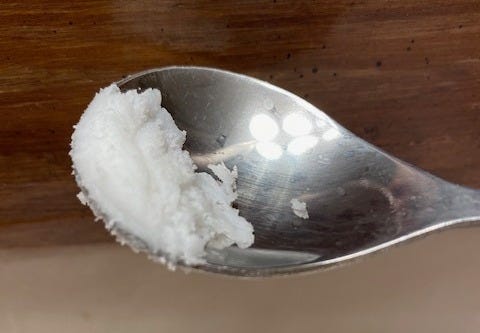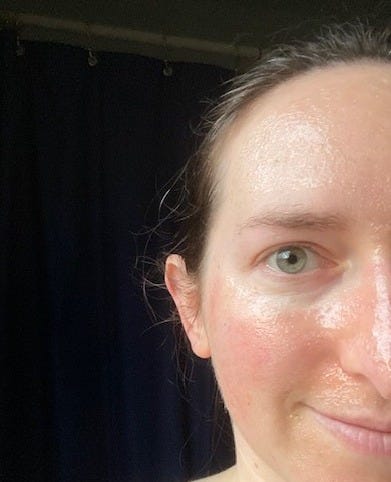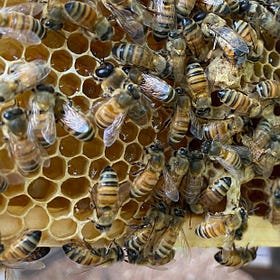Single-ingredient face mask: Honey
A very simple honey face mask recipe with many skincare benefits.
Winter isn’t over yet, but the coldest times are on their way out. While I prefer to wait until the spring equinox to officially say the colonies made it through winter, I’m in a state of suspended anxiety knowing probably all 10 of my colonies will need to be split in the coming weeks. Plus, my swarm traps go up next week. As the sole beekeeper of a hobby-scale honey farm, my brain cannot compute managing 20 hives. If you’re in the North Carolina region and interested in getting started with beekeeping or want to add bees to your apiary, please comment or contact me. If you’re a paid subscriber of this blog, you’ll get 10% off the cost of a nuc or hive. If you’re in my mentorship program, you can get up to 50% off. When available, I’ll have 3 options:
5-frame nuc $225
10 frames $300
20 frames $350
Price includes a 1-year-old laying queen that’s descended from Chatham County, North Carolina genetics over the past 8 years, workers, and drawn comb on medium frames. Delivery options available.
Enjoy honey before the honey flow
While I’ve been hibernating and enjoying winter time away from regular hive inspections, I’m also dealing with other seasonal changes like dry skin. I have a very simple recipe to share today: Honey. After honey’s edible quality, skincare is my favorite way to use it.
Honey provides skincare support due to its many qualities:
Hydrophilic. Honey is primarily water, but it’s also attracted to water.
Hygroscopic. Honey absorbs moisture from the air. You may see this manifest in crystallized honey. (Crystallized honey is still edible. If you want to re-liquify it, rest the jar in a warm bowl of water.)
Humectant. Honey pulls moisture into your skin. According to the JOURNAL OF COSMETIC DERMATOLOGY, “In cosmetic formulations, [honey] exerts emollient, humectant, soothing, and hair conditioning effects, keeps the skin juvenile and retards wrinkle formation, regulates pH and prevents pathogen infections.”
Hypertonic. Honey’s high sugar content draws moisture out of bacteria and kills them. Honey’s antimicrobial and antibacterial properties help support skin health. Dry skin introduces the risk of cracked skin, creating vulnerability for infection. Honey can help support a skin surface that discourages infection, which can be particularly helpful to those managing acne. Another part of this antibacterial activity comes with honey’s exposure to water. An enzyme in honey, glucose oxidase, creates hydrogen peroxide when diluted with water. Yet another reason why honey prevents bacterial growth is its low pH.
Healing. About a decade ago THE CENTRAL ASIAN JOURNAL OF GLOBAL HEALTH published, “There is evidence for free radical activity and reduced antioxidant scavenging capacity in burn wounds leading to oxidative stress. Honeys that are rich in antioxidants are likely to increase the antioxidant capacity of burn wounds and mop up free radicals.”
Although honey itself is a natural, gentle exfoliator, my favorite way to use a honey face mask is after exfoliating and before a deep moisturizer before going to sleep. However, sometimes I’ll throw on a honey mask before showering to get a skincare boost. Ideally, I’ll exfoliate with warm water and a baking soda paste and fully rinse and dry before applying honey. I’ll apply the honey and keep it on for 10 or 15 minutes, then rinse off in the shower. (Pro tip: Get undressed before applying the honey to prevent getting it on your clothes. I’m not a fan of bathrobes, so I use a convenient Velcro towel bath wrap.)
Post-honey mask
After rinsing and drying, my favorite moisturizer is home-rendered lard. Lard is hands down the most phenomenal moisturizer I’ve ever used. Lard is very similar to human skin oil. Lard can reduce fine lines, wrinkles, and scarring, tone and smooth skin, reduce pore size, and decrease inflammation. Lard also promotes collagen production and gives a vitamin and mineral boost. Pastured pigs store an incredible amount of Vitamin D in their fat. Their fat also contains Vitamins A, E, and omega-3 fatty acids. Our skin absorbs these nutrients. A word of caution: Pigs store toxins in their fat, so it’s imperative that you know the source of any lard you consume or apply to your skin.

Right now I’m down to the bottom of a jar, but our freezer is full of pig fat from the pigs I raised last year, so there’s plenty of lard ahead once I render more. If I don’t have any on hand, my next favorite moisturizer is coconut oil.
When traveling by plane and dry skin is essentially a guaranteed issue for me, I bring a TSA-friendly, 1-ounce jar of honey and another jar of coconut oil. It’s the perfect little DIY spa kit for the hotel.
Learn more uses of raw honey in skincare
A handful of topical honey uses
Honey can be used topically for general skincare, wound care, chronic skin issues, and many other conditions, but it’s important to distinguish which kind of honey and its source. With most commercial sources of honey completely adulterated and cut with corn syrup, or heated and stripped of medicinal properties, the appropriate honey for skincare is likely not found on a supermarket shelf....







I want to come over for a spa date!